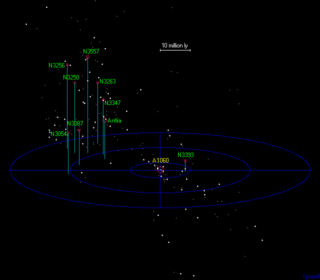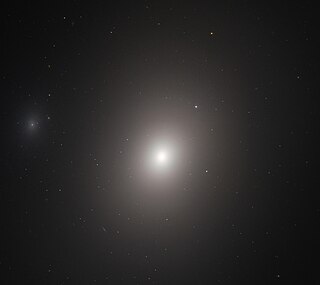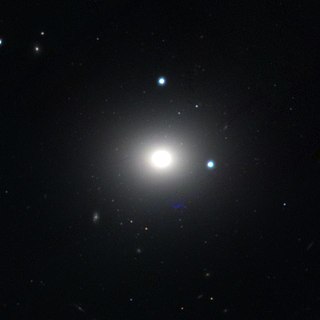
The Local Group is the galaxy group that includes the Milky Way. It has a total diameter of roughly 3 megaparsecs (10 million light-years; 9×1019 kilometres), and a total mass of the order of 2×1012 solar masses (4×1042 kg). It consists of two collections of galaxies in a "dumbbell" shape; the Milky Way and its satellites form one lobe, and the Andromeda Galaxy and its satellites constitute the other. The two collections are separated by about 800 kiloparsecs (3×10^6 ly; 2×1019 km) and are moving toward one another with a velocity of 123 km/s. The group itself is a part of the larger Virgo Supercluster, which may be a part of the Laniakea Supercluster. The exact number of galaxies in the Local Group is unknown as some are occluded by the Milky Way; however, at least 80 members are known, most of which are dwarf galaxies.

A rogue planet is an interstellar object of planetary mass which is not gravitationally bound to any star or brown dwarf. Rogue planets may originate from planetary systems in which they are formed and later ejected, or they can also form on their own, outside a planetary system. The Milky Way alone may have billions to trillions of rogue planets, a range the upcoming Nancy Grace Roman Space Telescope will likely be able to narrow.

The Hydra–Centaurus Supercluster, or the Hydra and Centaurus Superclusters, is a supercluster in two parts, the closest neighbour of Virgo Supercluster. It is located about 39 Mpc (127 Mly) away.

A dwarf galaxy is a small galaxy composed of about 1000 up to several billion stars, as compared to the Milky Way's 200–400 billion stars. The Large Magellanic Cloud, which closely orbits the Milky Way and contains over 30 billion stars, is sometimes classified as a dwarf galaxy; others consider it a full-fledged galaxy. Dwarf galaxies' formation and activity are thought to be heavily influenced by interactions with larger galaxies. Astronomers identify numerous types of dwarf galaxies, based on their shape and composition.

Messier 86 is an elliptical or lenticular galaxy in the constellation Virgo. It was discovered by Charles Messier in 1781. M86 lies in the heart of the Virgo Cluster of galaxies and forms a most conspicuous group with another large galaxy known as Messier 84. It displays the highest blue shift of all Messier objects, as it is, net of its other vectors of travel, approaching the Milky Way at 244 km/s. This is due to both galaxies falling roughly towards the center of the Virgo cluster from opposing ends.

NGC 4309 is a lenticular galaxy located about 55 million light-years away in the constellation Virgo. The galaxy was discovered by astronomer Christian Peters in 1881 and is a member of the Virgo Cluster.

NGC 5986 is a globular cluster of stars in the southern constellation of Lupus, located at a distance of approximately 34 kilolight-years from the Sun. It was discovered by Scottish astronomer James Dunlop on May 10, 1826. John L. E. Dreyer described it as, "a remarkable object, a globular cluster, very bright, large, round, very gradually brighter middle, stars of 13th to 15th magnitude". Its prograde–retrograde orbit through the Milky Way galaxy is considered irregular and highly eccentric. It has a mean heliocentric radial velocity of +100 km/s. The galacto-centric distance is 17 kly (5.2 kpc), which puts it in the galaxy's inner halo.

NGC 4323 is a lenticular or dwarf elliptical galaxy located about 52.5 million light-years away in the constellation Coma Berenices. The galaxy was discovered in 1882 by astronomer Wilhelm Tempel and is a member of the Virgo Cluster.

NGC 3311 is a super-giant elliptical galaxy located about 190 million light-years away in the constellation Hydra. The galaxy was discovered by astronomer John Herschel on March 30, 1835. NGC 3311 is the brightest member of the Hydra Cluster and forms a pair with NGC 3309 which along with NGC 3311, dominate the central region of the Hydra Cluster.

NGC 708 is an elliptical galaxy located 240 million light-years away in the constellation Andromeda and was discovered by astronomer William Herschel on September 21, 1786. It is classified as a cD galaxy and is the brightest member of Abell 262. NGC 708 is a weak FR I radio galaxy and is also classified as a type 2 Seyfert galaxy.

NGC 1395 is an elliptical galaxy located in the constellation Eridanus. It is located at a distance of circa 75 million light years from Earth, which, given its apparent dimensions, means that NGC 1395 is about 130,000 light years across. It was discovered by William Herschel on November 17, 1784. It is a member of the Eridanus Cluster.

NGC 4294 is a barred spiral galaxy with flocculent spiral arms located about 55 million light-years away in the constellation Virgo. The galaxy was discovered by astronomer William Herschel on March 15, 1784 and is a member of the Virgo Cluster.

NGC 4298 is a flocculent spiral galaxy located about 53 million light-years away in the constellation Coma Berenices. The galaxy was discovered by astronomer William Herschel on April 8, 1784 and is a member of the Virgo Cluster.

NGC 4299 is a featureless spiral galaxy located about 55 million light-years away in the constellation Virgo. It was discovered by astronomer William Herschel on March 15, 1784 and is a member of the Virgo Cluster.

NGC 4302 is an edge-on spiral galaxy located about 55 million light-years away in the constellation Coma Berenices. It was discovered by astronomer William Herschel on April 8, 1784 and is a member of the Virgo Cluster.

NGC 4305 is a dwarf spiral galaxy located about 100 million light-years away in the constellation Virgo. The galaxy was discovered by astronomer John Herschel on May 2, 1829. Although considered to be a member of the Virgo Cluster, its high radial velocity and blue luminosity suggest it is in fact a background galaxy. The galaxy has a nearby major companion; NGC 4306.

NGC 4306 is a dwarf barred lenticular galaxy located about 100 million light-years away in the constellation Virgo. The galaxy was discovered by astronomer Heinrich d'Arrest on April 16, 1865. Although considered to be a member of the Virgo Cluster, its high radial velocity and similar distance as NGC 4305 suggest that NGC 4306 is a background galaxy. NGC 4306 is a companion of NGC 4305 and appears to be interacting with it.
The Telescopium−Grus Cloud is a galaxy filament in the constellations of Pavo, Indus, and Telescopium. It was first defined by astronomer Brent Tully in his book The Nearby Galaxies Atlas and its companion book The Nearby Galaxies Catalog.

NGC 4324 is a lenticular galaxy located about 85 million light-years away in the constellation Virgo. It was discovered by astronomer Heinrich d'Arrest on March 4, 1862. NGC 4324 has a stellar mass of 5.62 × 1010M☉, and a baryonic mass of 5.88 × 1010M☉. The galaxy's total mass is around 5.25 × 1011M☉. NGC 4324 is notable for having a ring of star formation surrounding its nucleus. It was considered a member of the Virgo II Groups until 1999, when its distance was recalculated and it was placed in the Virgo W Group.


















